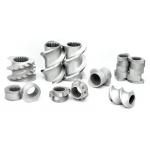Product Description:
Structural Design
Screw Assembly: Composed of different numbers of screw elements
with various functions, installed on a shaft with guide keys or a
hexagonal core shaft in a certain order and requirements. By
selecting different quantities and types of screw elements and
their combinations, it can adapt to different materials and process
requirements.
Barrel Structure: The main barrel is generally a segmented
structure, with each segment's temperature independently
controllable. Commonly, materials such as nitrided steel and
bimetallic are used for their wear and corrosion resistance, to
extend the service life.
Drive System: Includes a motor, reducer, couplings, etc., providing
power to the screws, enabling the two screws to rotate
synchronously, in the same direction, or in opposite directions.
Common drive methods include gear drive and chain drive.
Feeding System: Usually composed of screw-type metering feeders,
etc., it can uniformly and stably convey materials into the barrel
of the twin-screw extruder. Some are equipped with side feeders for
adding special additives or materials.
Exhaust System: Exhaust ports are set at appropriate positions in
the barrel and can be connected to vacuum pumps and other equipment
to remove volatile components and moisture generated during the
extrusion process, improving product quality.
Working Principle
Material Conveyance: Under the rotation of the screws, materials
enter the barrel from the feeding port and are pushed forward along
the barrel by the screw elements.
Melt Plasticization: As the materials move forward, they are
gradually heated, softened, and melted under the combined action of
the screws' shearing, extrusion, and barrel heating, transforming
from solid to liquid.
Mixing and Dispersion: Different functional screw elements, such as
kneading discs and toothed discs, perform intense shearing,
stirring, and mixing on the molten materials, ensuring uniform
dispersion of various components in the materials and achieving
good mixing results.
Exhaust and Volatiles Removal: When the materials reach the exhaust
section, due to the lower pressure at the exhaust ports, volatile
components and moisture in the materials escape under the pressure
difference, achieving the purpose of exhaust and volatiles removal.
Extrusion and Shaping: After plasticization, mixing, and exhaust,
the materials are pushed out from the die by the screws. Through
different die molds, they can be shaped into various products, such
as pipes, sheets, films, profiles, etc.
Performance Characteristics
High Flexibility: Due to the modular design, the combination of
screws and barrels can be quickly adjusted and replaced according
to different materials and process requirements, achieving multiple
functions and applications, and meeting the production needs of
different products.
Excellent Mixing Performance: It can efficiently shear, stir, and
mix materials, ensuring uniform dispersion of various components in
the materials and maintaining the stability and consistency of
product quality.
Good Self-Cleaning Performance: The closely meshed twin screws have
a self-cleaning function during rotation, effectively preventing
material accumulation and residue on the screw and barrel inner
walls, reducing cleaning frequency, and improving production
efficiency.
High Production Efficiency: The two screws of the twin-screw
extruder work simultaneously, offering greater material conveying
capacity and higher production efficiency compared to single-screw
extruders, meeting the demands of large-scale production.
Low Specific Energy Consumption: Under the same production
capacity, the modular twin-screw extruder has relatively lower
energy consumption, achieving better energy-saving effects and
reducing production costs.
Application Fields
Polymer Processing: Used in the modification, blending, filling,
and reinforcement of plastics, rubber, and other polymer materials,
such as the production of various high-performance engineering
plastics, thermoplastic elastomers, and plastic alloys.
Food Processing: Can be used in food extrusion, shaping, and
granulation processes, such as the production of breakfast cereals,
snack foods, and pet foods.
Chemical Products: In the chemical industry, it can be used for the
granulation, mixing, and dispersion of various chemical raw
materials, additives, pigments, and coatings. Automotive industry:
High-performance plastic materials required for the production of
automotive interior and exterior parts, engine components, etc.,
such as instrument panels, seats, bumpers, etc.
Building decoration: Can produce plastic products such as pipes,
profiles, and plates for the construction industry, such as PVC
pipes, PE water supply pipes, wood-plastic composite materials,
etc.









